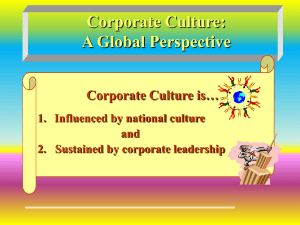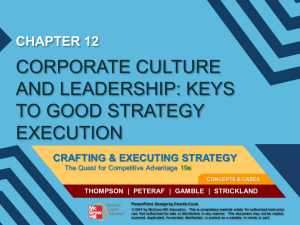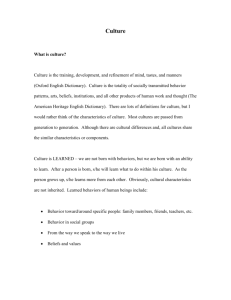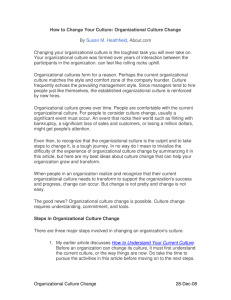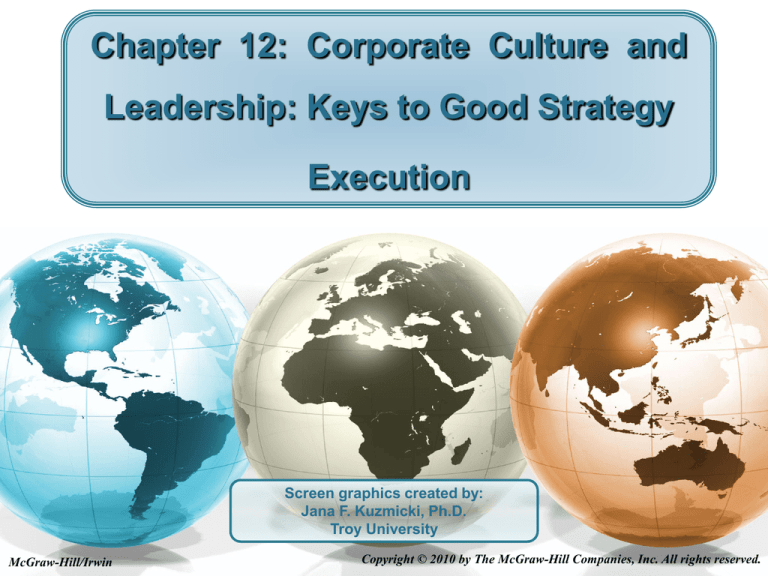
Chapter 12: Corporate Culture and
Leadership: Keys to Good Strategy
Execution
Screen graphics created by:
Jana F. Kuzmicki, Ph.D.
Troy University
McGraw-Hill/Irwin
Copyright © 2010 by The McGraw-Hill Companies, Inc. All rights reserved.
Chapter Learning Objectives
1. Be able to identify the key features of a
company’s corporate culture.
2. Understand how and why a company’s culture
can aid the drive for proficient strategy
execution and operating excellence.
3. Learn the kinds of actions management can take
to change a problem corporate culture.
4. Learn why corporate cultures tend to be
grounded in core values and ethical principles
and help establish a corporate conscience.
5. Understand what constitutes effective
managerial leadership in achieving superior
strategy execution and operating excellence.
12-2
Chapter Roadmap
Instilling a Corporate Culture that Promotes
Good Strategy Execution
Identifying the Key Features of a Company’s Corporate
Culture
Strong versus Weak Cultures
Unhealthy Cultures
High-Performance Cultures
Adaptive Cultures
Culture: Ally or Obstacle to Strategy Execution?
Changing a Problem Culture
Grounding the Culture in Core Values and Ethics
Establishing a Strategy-Culture Fit in Multinational
Companies
Leading the Strategy Execution Process
Making Corrective Adjustments in Timely Fashion
A Final Word on Managing the Process of
Crafting and Executing Strategy
12-3
INSTILLING A STRATEGYSUPPORTIVE CORPORATE
CULTURE
12-4
Defining Characteristics
of Corporate Culture
Core values, beliefs, and business principles
Ethical standards
Operating practices and behaviors defining
“how we do things around here”
Approach to people management
“Chemistry” and “personality” permeating
work environment
Oft-told stories illustrating
Company’s values
Business practices
Traditions
12-5
Identifying the Key Features
of Corporate Culture
A company’s culture is manifested in . . .
Values, business principles, and ethical standards
preached and practiced by management
Approaches to people management
and problem solving
Official policies and procedures
Spirit and character permeating work environment
Interactions and relationships among managers and
employees
Peer pressures that exist to display core values
Its revered traditions and oft-repeated stories
Its relationships with external stakeholders
12-6
Where Does Corporate
Culture Come From?
Founder or early leader
Influential individual or work group
Policies, vision, or strategies
Operating approaches
Company’s approach to people
management
Traditions, supervisory practices,
employee attitudes
Organizational politics
Relationships with stakeholders
12-7
How Is a Company’s Culture Perpetuated?
Selecting new employees who will “fit” in
Systematic indoctrination of new employees
Senior management efforts
to reinforce core values, beliefs,
principles, key operating practices
Story-telling of company legends
Ceremonies honoring employees
who display cultural ideals
Visibly rewarding those
who follow cultural norms
12-8
Forces Causing Culture to Evolve
New challenges in marketplace
Revolutionary technologies
Shifting internal conditions
Internal crisis
Turnover of top executives
A new CEO who opts to change things
Diversification into new businesses
Expansion into foreign countries
Rapid growth that involves adding many new
employees
Merger with or acquisition of another company
12-9
Company Subcultures: Problems Posed by New
Acquisitions and Multinational Operations
Values, beliefs, and practices within a company can
vary by
Department
Geographic location
Business unit
Subcultures can clash if
They embrace conflicting business philosophies
Key executives use different approaches to people
management
Differences between a company’s culture and recent
acquisitions have not been ironed out
Existence of subcultures does not preclude
important areas of commonality and compatibility
being established in different countries
12-10
Types of Corporate Cultures
Strong vs. Weak Cultures
Unhealthy Cultures
High-Performance Cultures
Adaptive Cultures
12-11
Characteristics of
Strong Culture Companies
Conduct business according to a
clear, widely-understood philosophy
Considerable time spent by management
communicating and reinforcing values
Values are widely shared and deeply rooted
Have a well-defined corporate character,
reinforced by a creed or values statement
Careful screening/selection of new
employees to be sure they will “fit in”
12-12
How Does a Culture Come to Be Strong?
Leader who establishes values and
behaviors consistent with
Customer needs
Competitive conditions
Strategic requirements
Values
Customers
Employees
Shareholders
A deep, abiding commitment to espoused
values, beliefs, and business philosophy
Practicing what is preached!
Genuine concern for well-being of
Customers
Employees
Shareholders
12-13
Characteristics of Weak Culture Companies
Lack of a widely-shared core set of values
Few behavioral norms
evident in operating practices
Few strong traditions
No strong sense of company identity
Little cohesion among departments
Weak employee allegiance to company’s
vision and strategy
12-14
Characteristics of Unhealthy Cultures
Highly politicized internal environment
Issues resolved on basis of political clout
Hostility to change
Avoid risks and don’t screw up
Experimentation and efforts to
alter status quo discouraged
“Not-invented-here” mindset – company
personnel discount need to look outside for
Best practices
New or better managerial approaches
Innovative ideas
Disregard for high ethical standards and
overzealous pursuit of wealth by key
executives
12-15
Characteristics of
High-Performance Cultures
Standout cultural traits include
A can-do spirit
Pride in doing things right
No-excuses accountability
A results-oriented work climate in which people go
the extra mile to achieve performance targets
Strong sense of involvement by all employees
Emphasis on individual initiative and creativity
Performance expectations are clearly identified
for all organizational members
Strong bias for being proactive, not reactive
Respect for the contributions of all employees
12-16
Hallmarks of Adaptive Cultures
Willingness to accept change and embrace
challenge of introducing new strategies
Risk-taking, experimentation, and
innovation to satisfy stakeholders
Entrepreneurship is
encouraged and rewarded
Funds provided for new products
New ideas openly evaluated
Genuine interest in well-being
of all key constituencies
Proactive approaches to
implement workable solutions
12-17
Culture: Ally or Obstacle
to Strategy Execution?
A company’s culture can contribute to – or
hinder – successful strategy execution
A culture that promotes attitudes and
behaviors that are well-suited to first-rate
strategy execution is a valuable ally in the
strategy execution process
A culture where attitudes
and behaviors impede
good strategy execution is a
huge obstacle to be overcome
12-18
Why Culture Matters: Benefits
of a Tight Culture-Strategy Fit
A culture that encourages actions and behaviors
supportive of good strategy execution
Provides employees with clear guidance regarding what behaviors
and results constitute good job performance
Creates significant peer pressure among co-workers to conform to
culturally acceptable norms
A deeply embedded culture tightly matched to the strategy
Aids the cause of competent strategy execution by top management
to culturally approved behaviors, thus
Making it far simpler for management to root out operating practices
that are a misfit
A culture imbedded with values and behaviors
that facilitate strategy execution promotes
strong employee commitment to the company’s
Vision
Performance targets
Strategy
12-19
Optimal Outcome of a
Tight Culture-Strategy Fit
A good job of culture-building
by managers
Promotes can-do attitudes
Encourages acceptance of change
Instills strong peer pressure for
strategy-supportive behaviors
Enlists enthusiasm and dedicated
effort to achieve company objectives
Closely aligning corporate culture with the
requirements for proficient strategy execution
merits the full attention of senior executives!
12-20
The Perils of Strategy-Culture Conflict
Conflicts between culturally-approved
behaviors and behaviors needed for good
strategy execution send mixed signals
Should employees by loyal to the culture and
company traditions and resist actions and
behaviors promoting better strategy execution?
Or should they support the strategy
by engaging in behaviors that run
counter to the culture?
When a company’s culture is out of sync with what is
needed for strategic success, the culture has to be
changed as rapidly as can be managed!
12-21
Creating a Strong Fit
Between Strategy and Culture
Responsibility of Strategy Maker –
Select a strategy compatible with the
sacred or unchangeable parts of
organization’s prevailing corporate culture
Responsibility of Strategy Implementer –
Once strategy is chosen, change
whatever facets of the corporate
culture hinder effective execution
12-22
Figure 12.1: Changing a Problem Culture
12-23
Menu of Culture-Changing Actions
Make a compelling case why a new cultural
atmosphere is in best interests of both company
and employees
Challenge status quo
Create events where employees
must listen to angry key stakeholders
Cite why and how certain behavioral norms and
work practices in current culture pose obstacles
to good execution of new strategic initiatives
Explain how new behaviors and work practices
to be introduced will be more advantageous
and produce better results
12-24
Substantive Culture-Changing Actions
Replace key executives strongly associated
with old culture
Promote individuals who have desired cultural
traits and can serve as role models
Appoint outsiders who have desired cultural
attributes to high-profile positions
Screen all candidates for new
positions carefully, hiring only those
who fit in with the new culture
Mandate all company personnel attend culture-
training programs to learn more about new work
practices, operating approaches, and behaviors
12-25
Substantive CultureChanging Actions (continued)
Push hard to implement new-style work
practices and operating procedures
Design compensation incentives to reward
teams and individuals who display the
desired cultural behaviors
Grant generous pay raises to individuals
who lead the way in adopting desired work
practices, displaying new-style behaviors,
and achieving pace-setting results
Revise policies and procedures
in ways to drive cultural change
12-26
Symbolic Culture-Changing Actions
Lead by example – Walk the talk
Emphasize frugality
Eliminate executive perks
Require executives to spend time talking
with customers
Ceremonial events to praise people and
teams who “get with the program”
Alter practices identified
as cultural hindrances
Visible awards to honor heroes
12-27
Grounding the Culture in
Core Values and Ethics
A culture based on ethical principles is
vital to long-term strategic success
Ethics programs help make
ethical conduct a way of life
Executives must provide genuine support
of personnel displaying ethical standards
in conducting the company’s business
Value statements serve as a cornerstone for
culture-building
12-28
Figure 12.2: The Two Culture-Building Roles of
a Company’s Core Values and Ethical Standards
12-29
Techniques to Transform Core Values and
Ethical Standards into Cultural Norms
Screen out applicants who do not exhibit
compatible character traits
Incorporate values statement and ethics code in
employee training programs
Strong endorsement by senior executives of the
importance of core values and ethical principles at
company events and in internal communications
Use values statements and codes of ethics as
benchmarks to judge appropriateness of company
policies and operating practices
Make the display of core values and ethical
principles a big factor in evaluating employee
performance
12-30
Techniques to Transform Core Values and
Ethical Standards into Cultural Norms (continued)
Make sure managers at all levels are diligent
in stressing the importance of ethical
conduct and observance of core values
Encourage everyone to use their influence in
helping enforce observance of core values
and ethical standards
Hold periodic ceremonies
to recognize individuals and
groups who display the values
Institute ethics enforcement procedures
12-31
Figure 12.3: The Benefits of Cultural Norms Strongly
Grounded in Core Values and Ethical Principles
12-32
Establishing a Strategy-Culture Fit in
Multinational and Global Companies
Institute training programs to
Communicate the meaning of core values and
Explain the case for common operating
principles and practices
Create a cultural climate where the norm is to
Adopt best practices
Use common work procedures
Pursue operating excellence
Give local managers
Flexibility to modify people management
approaches or operating styles
Discretion to use different motivational and
compensation incentives to induce personnel to
practice desired behaviors
12-33
Leading the
Strategy-Execution Process
12-34
Leading the Strategy-Execution Process
Top executives must be out
front personally
Leading the process and
Driving the pace of progress
Entire management team
must work diligently to engage
all employees by
Delegating authority to middle and lower-level
managers to move the implementation process
forward with all due speed
Empowering all employees to exercise initiative,
get things done in a timely, efficient, and
effective manner
12-35
Key Roles in Leading the
Strategy-Execution Process
Be out in the field, seeing
how well operations are going
Gather information firsthand
Gauge the progress being made
Be diligent and adept in spotting gridlock
Ferret out problems and issues
Learn the obstacles in the path of good
execution and clear the way for progress
Exert constructive, unrelenting pressure on
organizational units to
Demonstrate growing consistency in strategy
execution
Achieve performance targets
12-36
Making Corrective Adjustments
Requires deciding
When adjustments are needed
What adjustments to make
Involves
Adjusting long-term direction, objectives, and
strategy on an as-needed basis in response to
unfolding events and changing circumstances
Promoting fresh initiatives to bring internal
activities and behavior into better alignment with
strategy
Making changes to pick up the pace when
results fall short of performance targets
12-37
Process of Making Corrective Adjustments
Varies according to the situation
Crisis situation – Take remedial action quickly
Non-crisis situation – Incrementally solidify
commitment to a specific course of action
Deciding on specific corrective adjustments
is the same for both proactive and reactive
situations
Success in initiating corrective
actions hinges on
Thorough analysis of the situation
Exercise of good business judgment in deciding
on specific actions
Good implementation of the corrective actions
12-38

